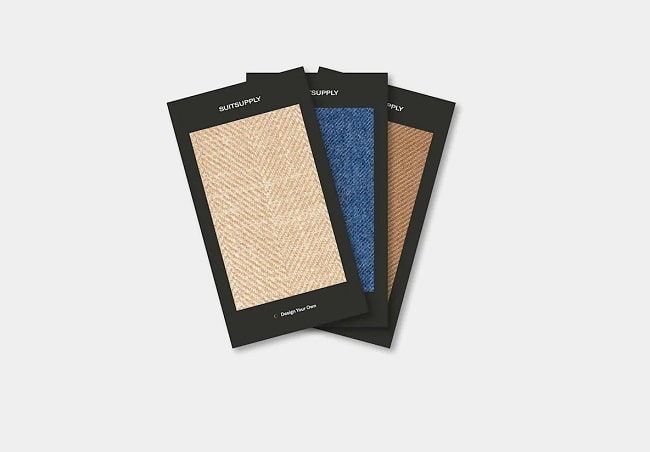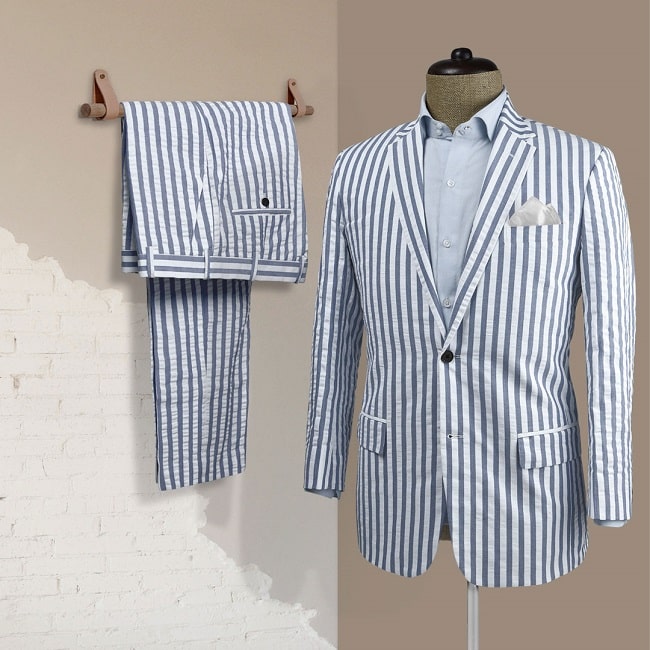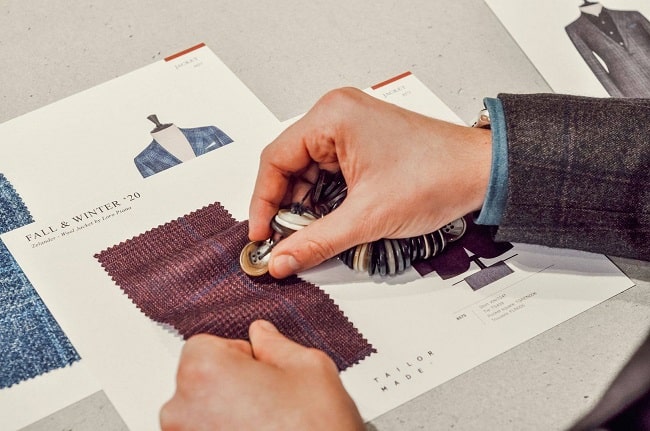1
HOME > Tips & Advice >
WHAT YOU NEED TO KNOW ABOUT BUYING A SUIT ONLINE
Written by Ivan Yaskey in Tips & Advice on the 12th July 2021

What do you do when buying a suit? It used to be, until about 15 years ago, you had two options. One, if you wanted to save money, you headed to the department store or the mall to find something off the rack that fit you closely. Or, if you were looking to make a serious, long-term investment, you worked with a local tailor to craft something bespoke or made-to-measure. In between these two, you might have also brought in the off-the-rack getup for some altering. Yet, the internet has expanded the suit-buying experience. The traditional approaches remain, but now, you have retailers all over the globe at your fingertips, presenting a vast, more varied array of fabrics, patterns, materials, and fits. Do you go slim – or try something oversized and double breasted? Do florals make sense – or are you on the hunt for textured charcoal twill? Then, there’s the made-to-measure online tailoring experience that lessens, if not eliminates, face-to-face interactions completely.
Despite the possibilities, buying a suit online has its downsides. For starters, you can easily end up with something that doesn’t fit well and can’t be altered to your proportions. Also, there’s the whole phenomenon of buying something that looks good in an eCommerce photo, only for the colour and proportions to be completely off once it arrives in the mail. In turn, don’t go into buying a suit online like you would a T-shirt. Rather, prepare with a more comprehensive understanding.

The Basics of Buying a Suit Online
It can seem like a lot at first. A lot of possibilities. A lot of colours. A lot to process before you know what you want. You’re the director of your search. Although you can explore and online window shop, at some point, it’s advised that you narrow down what you want before you supply your payment method. To get started:
Understand the Types of Suits Available
Suit-shopping online encompasses three basic types of options:
Vintage and Secondhand: You’ll pick this up from Etsy, Depop, eBay, or another secondhand marketplace. The suit is pre-worn or deadstock, likely with a limited number of sizes available. Follow all general tips for browsing for and buying vintage clothing. Understand that construction may be higher quality than something off the rack, but that tailoring and repairs will be needed. As well, especially for styles two-plus decades old, account for vanity sizing by knowing your measurements, which we touch on below.
Off the Rack: This ends up being the most common due to ease of production and subsequent availability. Off-the-rack covers everything from a polyester ensemble purchased through ASOS or H&M to more elevated fare from Suitsupply with a choice of sizes. You may be purchasing a full suit – jacket, trousers, and possibly a waistcoat – or venture into the world of suit separates.

For off-the-rack suiting, you’ll need to examine: The true, actual sizing. Read a size chart, and know if you’re looking at US/UK in inches versus European continental in centimetres. In the present, further account for vanity sizing by knowing your basic measurements.
The fit: Never buy an off-the-rack suit if you can’t first see it on a model with their height and weight indicated. As well, read the accompanying copy to determine if it’s intended to be relaxed, slim, or skinny.
The return policy: Does the store offer one? If so, what are the limitations?
Potential alternations: As the fit won’t be perfect, no matter how much you measure, prepare for tailoring, including budget and what to ask for. Not all features are easily altered, so be alert to any limitations.
Made-to-Measure and Bespoke: The tailoring experience gets translated to a digital interface. Made-to-measure suits start with you entering your measurements, often with some kind of consultation. Then, the brand uses these numbers to create a suit based on one of their pre-existing styles. A degree of customisation may be available, including for colours, fabrics, or details like buttons. Bespoke suiting online has grown in response to tailors closing up or limiting operations during the Covid-19 pandemic. Although the process is similar to made-to-measure, a stronger human touch is present. For both solutions, you may receive trial or preliminary garments in the mail to try on before the fit is finished or to return for minor alterations. Along these lines, your completed suit may arrive with an unfinished hem. This requires you to see an in-person tailor for minor length alterations, and discuss if you want no or a full break with your dress shoes. At this point, your suit should be fully done.

Take Your Measurements
In shopping for a suit online, you’re taking a risk if you completely skip the size chart. We recommend visiting this facet for any of the suit types described above to ensure the garment has as close of a fit as possible. Although a tailor takes more measurements during an appointment, the general ones you need to know are:
Your Chest: This number reflects the full circumference – although certain brands may only list the width or half of the full number.
Waist: This is where your trousers hang from your torso. As a note, certain brands may also list a separate measurement for hips. To anticipate this, measure where your trousers hit your mid-section, and then do the same for your hips to note any clear differences. In either case, don’t strictly go by the number on your existing trousers, as vanity sizing may come into play.
Inseam: You can either measure an existing pair of trousers, or you can take a measuring tape to record the distance from your groin to your ankle along the inside of your legs.
Know the Difference Between Fits
Not every suit will be cut identically. Especially as you’re shopping off-the-rack styles online, understand the differences between basic fits:
Skinny: This is your Thom Browne or St. Laurent suit or, for more of a High Street reference, what you’ll find from Twisted Tailor. The fabric sits close to the skin and won’t have much give, and tends to suit lean, sinewy bodies. Due to these factors, skinny suits have several limitations in terms of alterations.
Slim: Until fairly recently, most men’s suits featured a slim fit. Fabrics sit close to the skin, albeit with more room. Your trousers will more often than not be tapered, and the jacket slightly shorter to accommodate this line. To get more technical, slim suits tend to have a seven-inch difference between the waist and chest.
Modern or Regular: Whichever descriptor you see, the suit tends to feature a cut similar to a slim fit but with a bit more room. If your torso tends to be wider, a modern or relaxed fit better aligns with your body type.
Classic: This is the standard business suit fit, providing more space around the shoulders and torso.

Prepare for Alterations
Let’s get this out of the way. Your suit will probably need to be altered. It might not be significant, but if you’re after a perfect fit, even the most personalised online experience can’t get close to what an in-person tailor can achieve. In turn, anticipate these common alterations:
The chest: The suit jacket should sit flat on your chest, without bunching up or straining. It’s easier to alter a jacket when there’s extra material present rather than too little.
Lapels: Like the chest, these, too, should sit flat against your body, without sagging or straining when you button the jacket.
Sleeves: Your suit jacket’s sleeves should hit at your wrist without providing too much room surrounding. As well, your shirt’s cuffs should be partially visible. Yet, the jacket’s sleeve shouldn’t sit above the wrist, either.
Trousers: Although trousers may seem like they’ll need fewer alterations, this garment has potential to bag around the ankle, be too loose around the waist, or have too much space around the thighs, resulting in a shapeless appearance. To the other end, a fit that’s too tight – a greater possibility with a skinny or slim suit – can show straining around the front or rear.
The Pros and Cons of Buying a Suit Online
The internet has an edge as a marketplace for buying a suit based on the following:
Selection: Tailors and brick-and-mortar retailers just can’t match it. Those who’ve been hesitant to purchase a suit will now likely find something that clicks with them.
Affordability: Building off increased selection, the online medium gives you the opportunity to deal shop. In turn, you’re not stuck with the prices the closest department store offers.
Better customisation: We’re not comparing the quality you’ll get from a tailor just yet. However, the online made-to-measure model allows more people access to a semi-custom suit, versus having to settle for off-the-rack and altered or fully bespoke – and potentially out of your price range – from a tailor.

Yet, while the tailoring industry has embraced the possibilities of the online world, it’s not perfect.
The internet doesn’t replicate the experience of going to a tailor: If you’re truly after a bespoke suit, even the online made-to-measure experience won’t cover this entirely. The human touch is gone, and it’ll always feel like something’s missing. As well, the result, which can vary, doesn’t deliver the same quality and precision as working closely with someone in person.
You can’t feel the fabric: Even with greater customisation options, this tends to be a drawback for some customers, especially if you’re evaluating the differences between wool, twill, and tweed. Right now, even digital fabric swatches require you to use your imagination.
You risk experiencing a poor fit: Let’s be realistic: For all the advancements made, buying a suit online is still partially a crapshoot. Something could arrive in the mail that fits you pretty closely, with only minimal changes needed, or you could end up with something that’s too long in one area, too tight or short in another, and bunches up or bags around the shoulders. In turn, you’ll need to fork out a decent amount of cash for alterations and hope a tailor can even it out.

Trending
2
3
4
5
6
7
8
9
10










